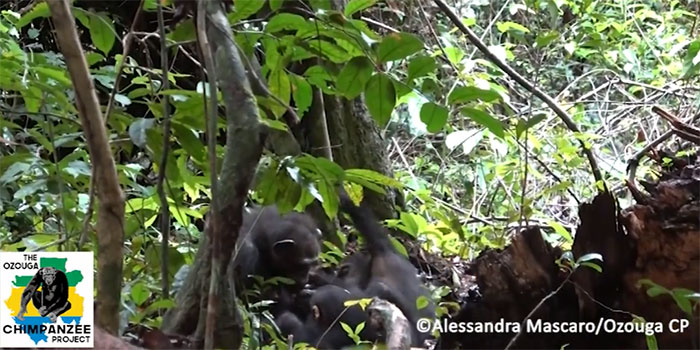Researchers have discovered that chimpanzees catch flying insects, press them against their lips, and place them on wounds, repeating the process multiple times as if to treat them.
A mother chimpanzee named Suzee catches an insect and places it on the wound of her son Sia, who is male. (Video: Alessandra Mascaro)
Scientists have been studying a group of 45 chimpanzees in Loango National Park in Gabon, West Africa, since 2005. From November 2019 to February 2021, they observed 22 individuals with 76 open wounds.
In 19 instances, they found that chimpanzees exhibited self-medication behavior using insects as “medicine.” Some even used this method to treat other individuals. The study was published in the journal Current Biology on February 7.
Initially, the chimpanzees catch a flying insect and immobilize it by pressing it between their lips. They then place the insect on the wound, moving it with their fingertips. Finally, the chimpanzees use their mouths or fingers to remove it. They often place the insect on the wound and then remove it multiple times.

Chimpanzee places an insect on a wound, moving it with its fingertips.
The research team is unsure what type of insects the chimpanzees are using and how this method specifically aids in wound healing. They have only identified that the chimpanzees typically use small, dark-colored flying insects. There is no evidence that the chimpanzees consume the insects; they only press the creature with their lips and apply it to the wound.
One explanation for this behavior is that certain components of the insects may have anti-inflammatory or antiseptic properties, or it could simply be a part of the chimpanzees’ “local culture,” similar to some human healing practices.
Scientists have previously documented self-medication in animals, such as dogs and cats consuming plants to induce vomiting, bears and deer eating medicinal plants, and orangutans using plant materials to soothe muscle injuries. However, they had never observed any other mammals, apart from humans, using insects for medicinal purposes.
The research team even observed chimpanzees using this technique with each other. For example, the adult female chimpanzee Carol catches an insect and gives it to the adult male chimpanzee Littlegrey. Littlegrey holds the insect between his lips and then places it on a wound. Subsequently, two other chimpanzees also assist him in holding the insect, placing it on and moving it over the wound.
Some animals cooperate with others in similar ways, according to study author Simone Pika, head of the Animal Cognition Laboratory at the University of Osnabrück, Germany. “However, we have never known of any other case in mammals. This could be a learned behavior that exists only within this group,” Pika stated.
In some of their social behaviors, humans engage in cooperation that involves an exchange of benefits. For instance, grooming helps remove parasites for another chimpanzee while providing an insect meal for itself.
However, in the cases of using insects to treat wounds in others that Pika observed, the chimpanzees did not receive any clear benefits in return. According to her, this suggests that they are participating in actions that enhance “the welfare of another individual” and helps scientists gain further insights into chimpanzee social relationships.


















































